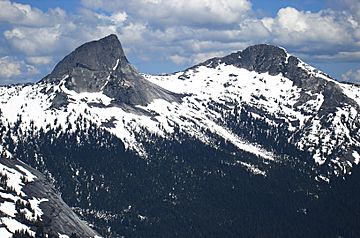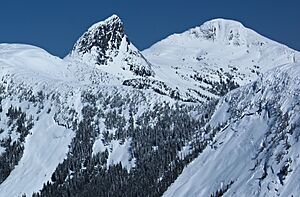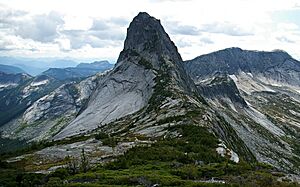Vicuna Peak facts for kids
Quick facts for kids Vicuna Peak |
|
|---|---|

Vicuna Peak, left, with Guanaco Peak (right)
|
|
| Highest point | |
| Elevation | 2,126 m (6,975 ft) |
| Prominence | 156 m (512 ft) |
| Parent peak | Guanaco Peak (2127 m) |
| Geography | |
| Location | British Columbia, Canada |
| Parent range | North Cascades |
| Topo map | NTS 92H/11 |
| Climbing | |
| First ascent | October 13, 1974, by Philip Kubik, Ed Zenger |
| Easiest route | Northeast Ridge |
Vicuna Peak, also known as Vicuña Peak, is a tall mountain in British Columbia, Canada. It stands at 2,126-metre (6,975-foot) high. This mountain is part of the North Cascades range in southwestern British Columbia. It is a horn, which means it has a sharp, pointed shape.
Vicuna Peak is about 8 km (5 mi) northwest of Coquihalla Summit. It is also very close to Guanaco Peak, being only one meter shorter. Water from the peak flows into the East Anderson River to the west. To the east, it flows into the Coldwater River.
The mountain was named after the vicuña, an animal similar to a llama. This name fits with other nearby peaks that are also named after animals. Philip Kubik, who was part of the first group to climb the mountain in 1974, suggested the name. The name was officially accepted on February 5, 1976.
How Mountains Form
The Cascade Range mountains, including Vicuna Peak, began forming millions of years ago. This happened during the late Eocene Epoch. The North American Plate slowly moved over the Pacific Plate. This movement caused many volcanic eruptions.
Also, small pieces of the Earth's crust, called terranes, joined together. This process helped create the North Cascades about 50 million years ago.
Over two million years ago, during the Pleistocene period, large sheets of ice called glaciers moved across the land. These glaciers carved out the "U"-shaped valleys we see today. The combination of land pushing up (uplift) and cracks in the Earth (faulting) with the glaciers created the tall peaks and deep valleys of the North Cascades.
The North Cascades has very rugged land. It features sharp peaks, rocky ridges, and deep valleys carved by glaciers. These geological events created the different landscapes and big changes in height. This also led to different climates and types of plants in the area.
Mountain Weather
Vicuna Peak is in a marine west coast climate zone. This type of climate is common in western North America. Most weather systems start over the Pacific Ocean. They then travel east towards the Cascade Range.
When these weather systems hit the mountains, they are forced to rise. This process is called Orographic lift. As the air rises, it cools and drops its moisture. This causes a lot of rain or snow, especially in winter.
Temperatures on Vicuna Peak can get very cold. They can drop below −20 °C. With wind, it can feel even colder, below −30 °C. The best time to climb Vicuna Peak is usually from July through September. The weather is most pleasant during these months.
Climbing the Peak
There are several ways to climb Vicuna Peak. Here are some of the known climbing paths:





